
Java 队列数据结构与算法
队列的结构
可以把队列想象成排队买票,先来的先买,后来的人只能站在末尾,不允许插队。
队列最大的特点就是先进先出,主要的两个操作是入队和出队。跟栈一样,它既可以用数组来实现,也可以用链表来实现。用数组实现的叫顺序队列,用链表 实现的叫链式队列。特别是长得像一个环的循环队列。在数组实现队列的时候,会有数据搬移操作,要想解决数据搬移的问题,就需要循环数组实现的循环队列。
先进者先出,是典型的“队列”。
后进者先出,先进者后出,是典型的“栈”结构。
栈只支持入栈push()和出栈pop()两个操作。
队列只支持:入队enqueue(),放一个数据到队列的尾部;出队dequeue(),从队列头部去一个元素。
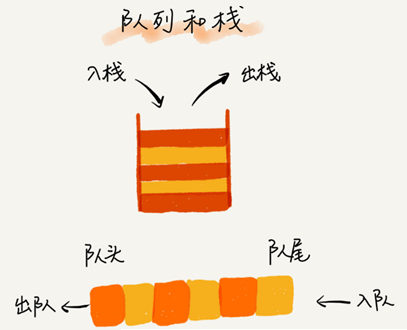
队列跟栈一样也是一种操作受限的线性表数据结构。
循环队列、阻塞队列、并发队列等具有某些额外特性的队列,他们在很多偏底层系统、框架、中间件的开发中,起着关键性的作用。
比如高性能队列Disruptor、Linux环形缓存,都用到了循环并发队列;
java concurrent并发包利用ArrayBlockingQueue来实现公平锁等。
队列的实现
用数组实现的队列叫做顺序队列,用链表实现的队列叫做链式队列。
数组实现的顺序队列
java基于数组的实现
// 用数组实现的队列
public class Arrayqueue{
// 数组:items,数组大小:n
private String[] items;
private int n = 0;
// head表示队头下标,tail表示队尾下标
private int head = 0;
private int tail = 0;
// 申请一个大小为capacity的数组
public ArrayQueue(int capacity){
items = new String[capacity];
n = capacity;
}
//入队
public boolean enqueue(String item){
// 如果tail == n表示队列已经满了
if (tail == n ){
return false;
}
items[tail ++] = item;
return true;
}
//出队
public String dequeue(){
// 如果head == tail表示队列为空
if (head == tail){
return null;
}
return items[head ++];
}
}队列需要两个指针:一个head指针,指向队头;一个是tail指针,指向队尾。
当a、b、c、d依此入队之后,队列中的head指针指向下标为0的位置,tail指针指向下标为4的位置。
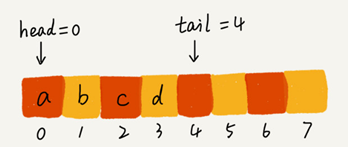
调用两次出队操作之后,队列中head指针指向下标为2的位置,tail指针仍然指向下标为4的位置。
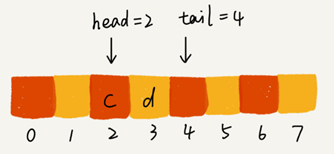
随着不停地入队、出队操作,head和tail都会持续往后移动。
当tail移动到最右边,即使数组中还有空闲空间,也无法继续往队列中添加数据了。这时只需要触发依此数据的搬移操作即可:
// 入队操作,将item放入队尾
public boolean enqueue(String item){
// tail == n表示队列末尾没有空间了
if (tail == n){
// tail == n && head == 0,表示整个队列都占满了
if (head == 0){
return false;
}
// 数据搬移
for (int i = head; i < tail; i++){
items[i - head] = items[i];
}
//搬移完之后重新更新head和tail
tail -= head;
head = 0;
}
items[tail ++] = item;
return true;
}上面代码中,当队列的tail指针移动到数组的最右边后,如果有新的数据入队,就将head到tail之间的数据,整体搬移到数组中0和tail - head的位置。
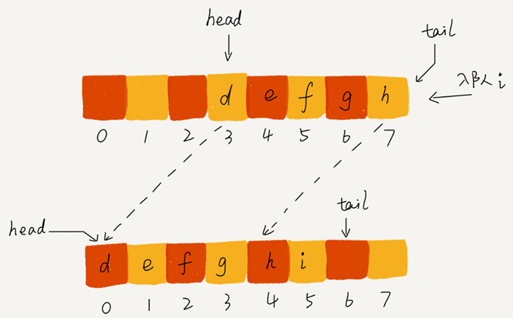
这种实现思路中,出队入队操作的时间复杂度是O(1)。
链表实现的链式队列
基于链表的实现,需要head和tail两个指针。分别指向链表的第一个和最后一个结点。
入队时,tail -> next = new_node,tail = tail -> next;出队时,head = head -> next。
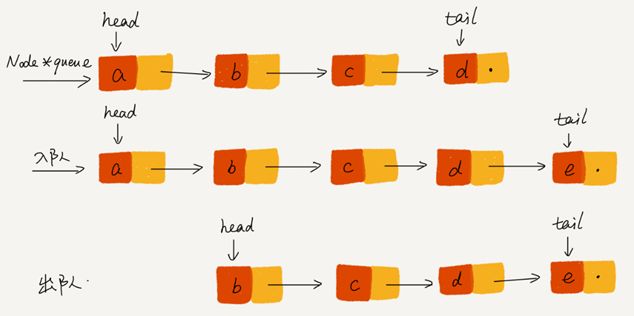
public class QueueBasedOnLinkedList{
// 队列的队首和队尾
private Node head = null;
private Node tail = null;
// 入队
public void enqueue(String value){
if (tail == null){
Node newNode = new Node(value, null);
head = newNode;
tail = newNode;
} else {
tail.next = new Node(value, null);
tail = tail.next;
}
}
// 出队
public String dequeue(){
if (head == null){
return null;
}
String value = head.data;
head = head.next;
if (head == null){
tail = null;
}
return value;
}
public void printAll(){
Node p = head;
while(p != null){
System.out.print(p.data + " ");
p = p.next;
}
System.out.println();
}
private static class Node {
private String data;
private Node next;
public Node(String data, Node next){
this.data = data;
this.next = next;
}
public String getData(){
return data;
}
}
}循环数组实现的队列
上面用数组实现队列的时候,在tail == n时,会有数据搬移操作,采用循环数组则不需要数据搬移操作。
原本数组是有头有尾的一条置线,把它首尾相连扳成一个环:
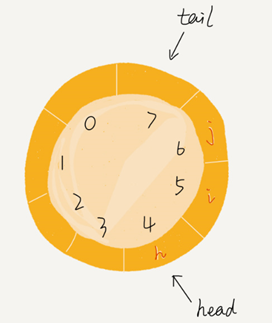
图中这个队列的大小为8,当前head = 4,tail = 7。
当有一个新的元素a入队时,放入下标为7的位置,tail并不更新为8,而是到下标为0的位置。
当再有一个元素b入队时,将b放入下标为0的位置,然后tail加1更新为1。
在a、b依此入队之后,循环队列中的元素就变成了下面的样子:
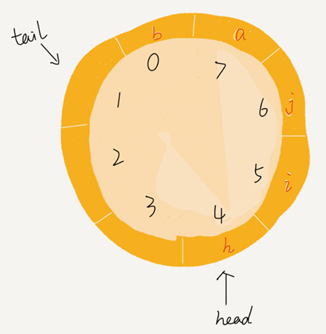
确定队空和队满的判定条件。
队列为空的判断条件是head == tail。

如上图,显然队列满的判断条件是(tail + 1) % n = head,为了避免和对空的判断条件混淆,则必须牺牲一个数组的存储空间。
java实现代码:
public class CircularQueue{
// 数组:items,数组大小:n
private String[] items;
private int n = 0;
// head表示队头下标,tail表示队尾下标
private int head = 0;
private int tail = 0;
// 申请一个大小为capacity的数组
public CircularQueue(int capacity){
items = new String[capacity];
n = capacity;
}
// 入队
public boolean enqueue(String item){
//队列满了
if ((tail + 1) % n == head){
return false;
}
items[tail] = item;
tail = (tail + 1) % n;
return true;
}
//出队
public String dequeue(){
// 如果head == tail表示队列为空
if (head == tail){
return null;
}
return items[(head + 1) % n];
}
}队列在实际开发中的应用
阻塞队列
阻塞队列其实就是在队列基础上增加了阻塞操作。简单来说,就是在队列为空的时候,从队头取数据会被阻塞。因此此时还没有数据可取,知道队列中有了数据才能返回;如果队列已经满了,那么插入数据的操作就会被阻塞,直到队列中有空闲位置后再插入数据,然后再返回。
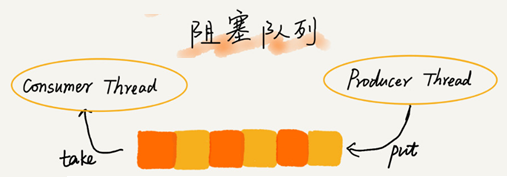
使用阻塞队列,就可以轻松实现一个“生产者-消费者模型”。
这种基于阻塞队列实现的“生产者-消费者模型”,可以有效地协调生产和消费的速度。当“生产者”生产数据的速度过快,“消费者”来不及消费时,存储数据的队列很快就会满了。这个时候,生产者就阻塞等待,直到“消费者”消费了数据,“生产者”才会被唤醒继续“生产”。
还可以通过协调“生产者”和“消费者”的个数,来提高数据的处理效率。
可以多配置几个“消费者”,来应对一个“生产者”:
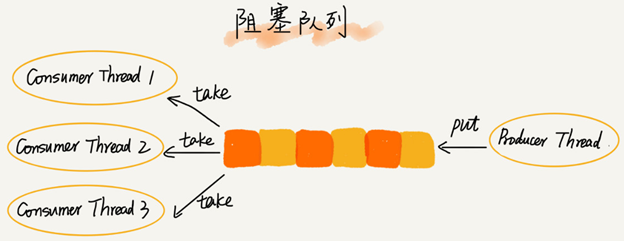
python基于阻塞队列实现的生产者-消费者模型:
本文系作者在时代Java发表,未经许可,不得转载。
如有侵权,请联系nowjava@qq.com删除。
